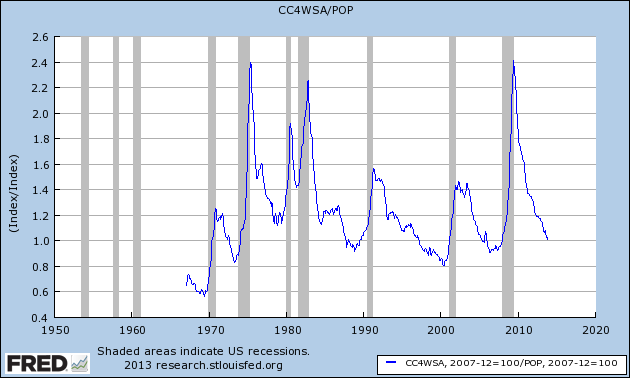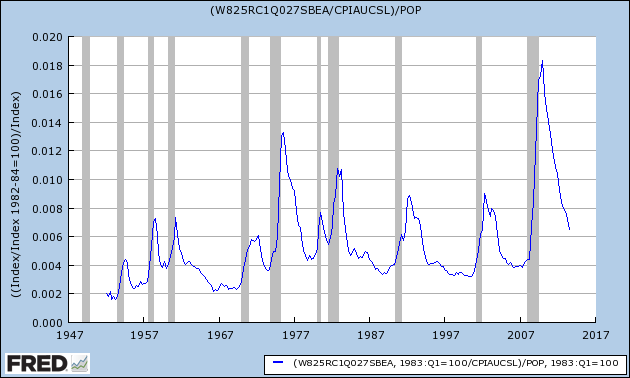Arguing Over Extending Unemployment Benefits
Econintersect LLC | Dec 15, 2013 03:53AM ET
Nobel Laureate Paul Krugman like the one Professor Krugman referenced ) reference other studies – and when you start running down each of the referenced studies, most are nothing more than taking a few data points and extrapolating a conclusion. The overriding concern is the validity of any study prior to the economic reset which occurred in 2007 (aka the Great Recession) – which likely created a very different set of dynamics than any past study periods (except for the Great Depression).
I do not have any issue with the concept of unemployment benefits – nor would I be fundamentally against extending benefits. I do admit to having several caution flags:
- unemployment benefits should not impede the reset to the new normal;
- unemployment benefits cannot approach the benefits of having a real job.
To quantify the situation, unemployment benefits (indexed to population growth) have returned to post recession levels, and are currently at the levels seen in times of economic expansion.
Figure 1 – Relative Number of People Receiving Unemployment Benefits, Indexed for Population Growth

The states (who are responsible for unemployment insurance execution) set the benefits whilst getting government support. From the Department of Labor:
The Federal-State Unemployment Insurance Program provides unemployment benefits to eligible workers who are unemployed through no fault of their own (as determined under State law), and meet other eligibility requirements of State law.
- Unemployment insurance payments (benefits) are intended to provide temporary financial assistance to unemployed workers who meet the requirements of State law.
- Each State administers a separate unemployment insurance program within guidelines established by Federal law.
- Eligibility for unemployment insurance, benefit amounts and the length of time benefits are available are determined by the State law under which unemployment insurance claims are established.
The states get support from the federal government for unemployment benefits paid to the unemployed as long as they meet the federal guidelines. The amount of real unemployment benefit payments into the economy remain high for non-recessionary periods. Graph below is indexed and inflation adjusted.
Figure 2 – Inflation and Population Indexed Total Unemployment Benefits Paid

In other words,
- the number of people receiving unemployment benefits are in a normal range for times of economic expansion
- but the amount of benefits being paid are higher than the normal range – implying the real compensation in this current period is higher than previous periods.
With hat tip to fileunemployment.org – here is the maximum unemployment benefits by state:
Figure 2 – Maximum Weekly Unemployment Benefits Paid by State
How much would someone trying to find a job make if they were paid minimum wage?
- Part time employment per the Obamacare criteria would only compensate a little over $200 per week;
- and full time employment at minimum wage averages more than $300 per week.
Are too high of unemployment benefits (or too low minimum wage) creating an incentive NOT to go back to work?
The issue at this juncture is whether extending the unemployment benefits are a good use of a social safety net to assist those who are in need – or just an unneeded crutch in times of economic expansion which could now become an incentive not to find a job. Unfortunately there is truth in both opposing opinions. And no data conclusive analysis that I have found.
Other Economic News this Week:
The Econintersect economic forecast for Click here to view the scorecard table below with active hyperlinks
Trading in financial instruments and/or cryptocurrencies involves high risks including the risk of losing some, or all, of your investment amount, and may not be suitable for all investors. Prices of cryptocurrencies are extremely volatile and may be affected by external factors such as financial, regulatory or political events. Trading on margin increases the financial risks.
Before deciding to trade in financial instrument or cryptocurrencies you should be fully informed of the risks and costs associated with trading the financial markets, carefully consider your investment objectives, level of experience, and risk appetite, and seek professional advice where needed.
Fusion Media would like to remind you that the data contained in this website is not necessarily real-time nor accurate. The data and prices on the website are not necessarily provided by any market or exchange, but may be provided by market makers, and so prices may not be accurate and may differ from the actual price at any given market, meaning prices are indicative and not appropriate for trading purposes. Fusion Media and any provider of the data contained in this website will not accept liability for any loss or damage as a result of your trading, or your reliance on the information contained within this website.
It is prohibited to use, store, reproduce, display, modify, transmit or distribute the data contained in this website without the explicit prior written permission of Fusion Media and/or the data provider. All intellectual property rights are reserved by the providers and/or the exchange providing the data contained in this website.
Fusion Media may be compensated by the advertisers that appear on the website, based on your interaction with the advertisements or advertisers.